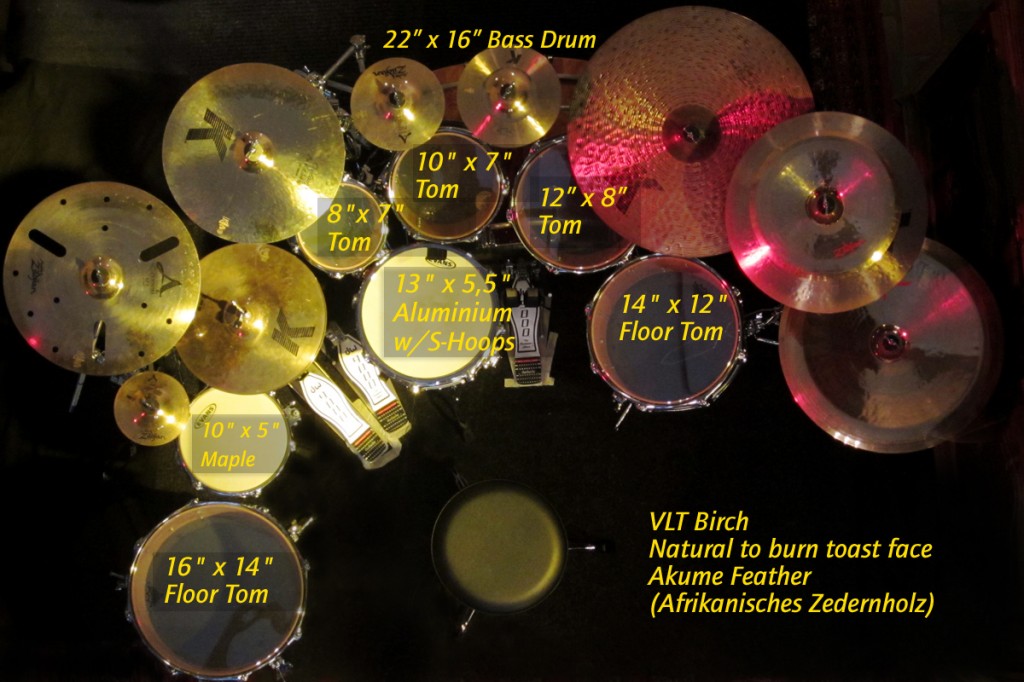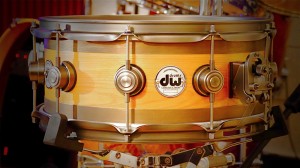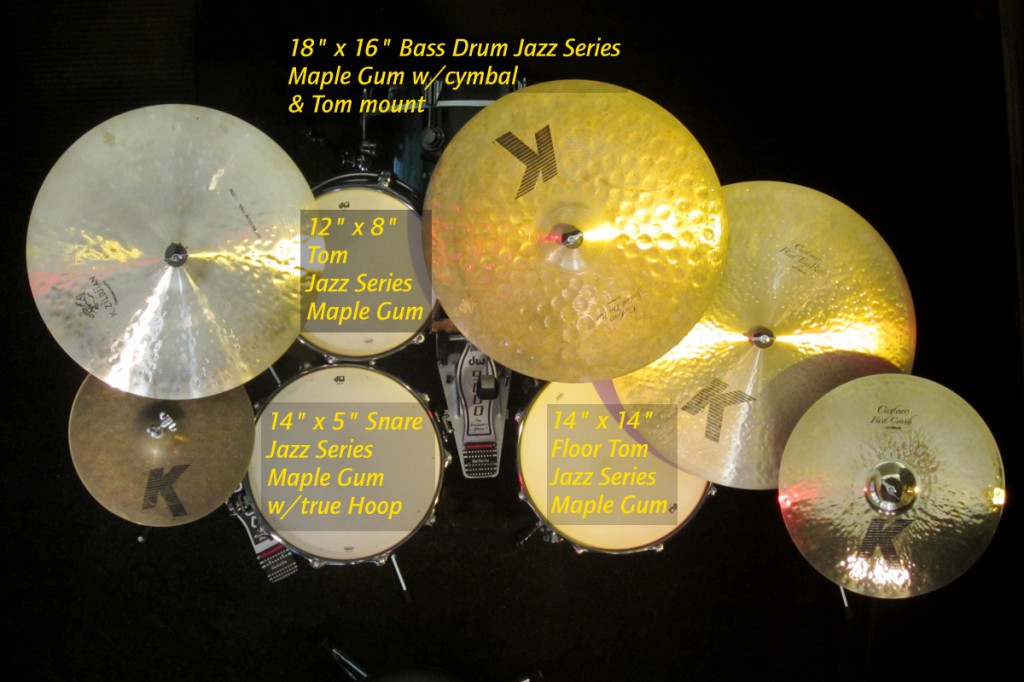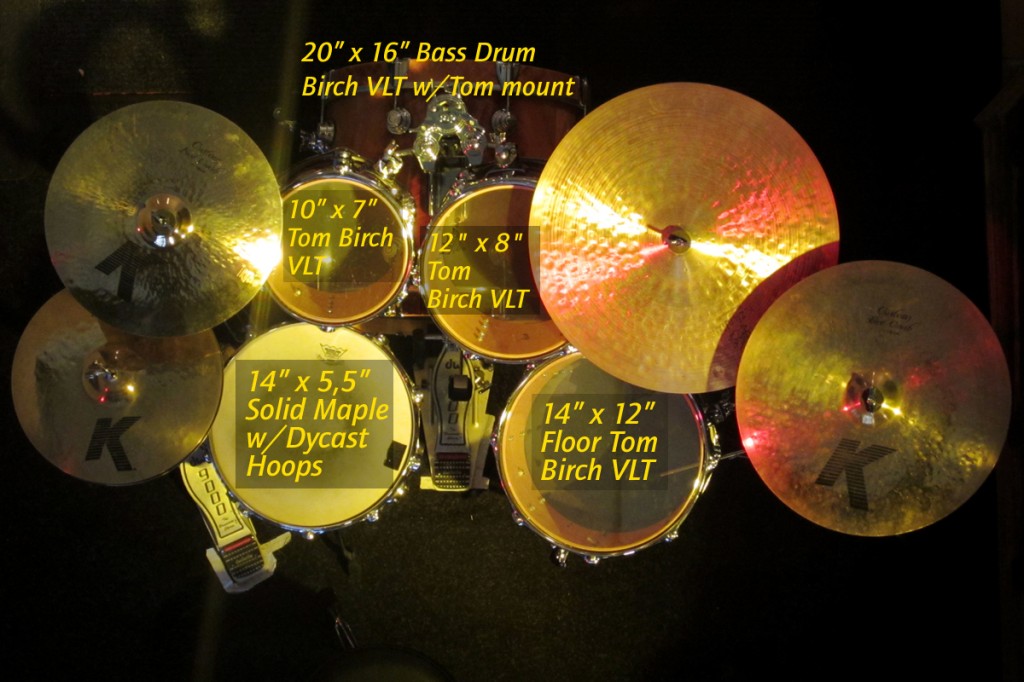DW Drums & Remo Heads
Why do you play these drums and heads?
Prologue
The question about why I am using exactly these drums – shell sizes, wood, combination of heads – obviously is a question of our individual musical origin from which our idea of sound came into being; as well as it is a question of the musical environment that we are living in.
Being a kid of the 60´s, I grew up under the influence of Jazz, Rock and Fusion and was fascinated by the variaty of sound and power of drums. I got an early influence of drum sound by listening to Billy Cobham, Steve Gadd, Tony Williams but also Joe Morello, Mitch Mitchel, Ian Paice or Carl Palmer. The warmth of (Gretch) Tony Williams tom sound still with the crisp attack, the funky (Tama) snare and tom Sound of Billy Cobham, the warm and full sounding (Ludwig) Bass Drum of Joe Morello, the integretively (Yamaha) all over drumsound of Steve Gadd as well as the vivid open (Ludwig) volume of a Mitch Mitchel or John Bonham were always presenting me the full spectrum of a solid drum sound.
My parents had a great influence on me since they were listening to a lot of Jazz, Big Band, Rock and Soul. Maybe that´s why I am still having a favour for a mixture of Jazz and Rock: the high pitched snare drum in a rock setting as played by Ian Paice, the funky approach of Buddy Rich, the Rock sound of Tony Williams or the jazz phrasing of John Bonham with his big drum sound.
As a little kid, I was very impressed by the creativity of Carl Palmer who was using a ship bell during his drum solo or blew up his floor tom with an air pump while playing – creating an effect of an African talking drum – and performing a classical piece of music (Pictures of an Exhibition, Petrowitsch Mussorgsky).
I am writing all this to show, that you should not simply go to a music retailer – or even worse: surf to an online-shop – to buy a drum set and beat on it! Think beforehand of the sound, you want to achieve and why you want to use that sound in a musical setting. To gain this vision takes years of experience which however can always change and go into another direction.
About the drums
Since 2007 I am proudly endorsing DW Drums and I am always fascinated about the nearly childlike delightment of John Good when he is presenting a new wood or a new way of production that he has found! Often the new invention is a reminiscence to the old days as for example the Jazz Series with its real hoops. It´s a jazz drum sound of the 50´s in a new format. So this is to say thank you to John Good and his team to let me be part of it.
For many years, I have been playing maple shells and – being influenced by the music and the music scene of those days – have tried many sizes of toms and bass drums. Since I have been working in a lot of different musical settings, I was always looking for a set, that I can use most flexibel and gives me enough freedom. I like the punch and the warmth of maple but I have found myself using thinner heads to get more liveness and attack to the toms (for example: Remo ambassador or emperor smooth white). The first step into the direction of a wood change, was when I was using a 22×18“ Pearl birch bass drum (still with my maple toms) . The bass drum sounded phantastic – however it was quite unflexible because of its depth and demanding sound. Of course there was no way to use it in Jazz or even en „easy pop“ sound.
By that time I was able to get a hand on the GMS Jazz Set that John Riley was using for example on the recording for his great method book „Art of Bebop Drumming“. Of course, I was very happy with it and still use it sometimes.
With my change to DW drums and a long time of investigating, I decided to got for a birch shell set with rather short depths.
Bass Drum & Heads
As in the early days, I am using a 22×16“ shell for the bass drum with VLT (vertical low timbre) – just as for the toms. VLT gives me a very balanced full bass and the wood a quite fast attack. Right now, I am using the Remo Powerstroke 3 head as a batter and the DW head with a little whole for miking and sound-control as a front head. I am using a little damping with a pillow inside that puts a little dampening on the front head. I tune the batter head as low as possible – that it nearly gets wrinkels – and the front a little higher to give a little tone.
This bass drum works nearly everywere: in the studio, live on stage, acoustic or miked,
it is very flexible for various stiles from Rock, Pop, Big Band but also for smaller rather soft dinner jobs.
As an alternativ, I am using a 20×16“ bass drums – again: VLT birch. This particular bass drum has a mountable tom holder which makes it a little easier in setting up and down. Franktly speaking, I don´t think that the tom mount on the bass drum has a significant infuence on the tone oft he bass drum. Because of its size, the drum doesn´t have such a big deep tone as the 22“ inch bass drum, however it can also be used for Rock – miked over P.A. – and carries a band still with a fat foundation. I like to use the 20×16“ because it reacts a little faster and seems to be more alive. The sound – again with double headed skins and a little dampening – is great for Funk, Fusion and can be used for smaller gigs that don´t need so much volume. With single headed coated heads, it can easily be used for Jazz.
Toms
For toms I also switched to birch and I am using rather short VLT-shells (8×7, 10×7, 12×8). This gives me a lot of flexibility in attack, in setting up the drums, they are not heavy for carrying and still sound rich with a lot of volume. Last not least because of aesthetic reasons, I am using floor toms – again with short sizes (14×12, 16×14). I always felt quite uncomfortable using deep toms on a double mounting stand; they were rather inflexible and the stand is heavy to carry. Nowadays, there is actually no big difference in the character of the sound of a floor tom and the smaller mounted toms. Apart from that, I love to fool around and experience with my set up: for example, I am using my 16×14“ right next to the 10×5 snare to my left. This gives a great contrast between the very high snare and the low tom! For my regular gigs, I am just playing a small set sometimes with only on 10“ tom and the floor tom – again much easier to handle with a floor tom.
Tom Heads
For batter heads, I am always trying new things and use different models depending on the production or how I feel.
I went from one extrem to another by using single ply skins on my birch toms – such as Remo Ambassador clear – or double ply skins – such as Remo Emperor coated. I like the crunchy sound of coated heads just as the brilliant clear sound of not coated heads. Every combination has advantages and disadvantages.
You have to be very carefull and precise by tuning single ply heads that can have a lot of overtones, can sound rather hard and can ring quite long – however playing them on a studio gig can be just great if you are looking for a tom sound with a lot of tone and sustain such as Chat Wackermans´ tom sound (Maple with G1 clear single ply heads which I can get with Remo Ambassoador clear heads). Thicker heads usually have more punch and always work for Rock, Pop, on stage and over a P.A. system. I balance the less of attack of double ply (thicker) heads by the use of birch shells which is more vivid, by tuning them sightly higher or by using thinner resonant heads. For many years, I was using thinner Remo diplomat resonant heads with coated emperors on my Pearl maple toms and it worked well. Because of the birch shell of my DW kit, I do not need thinner resonant heads, since the attack is right there.
It is quite interesting to use the same head as a batter and resonant head. At least for me this doesn´t work for double ply heads but definitely for single ply heads such as the coated ambassador. You can find this on many Jazzdrums. You can also try to use thinner heads for smaller anf thicker heads for bigger toms; for example a coated ambassador for the 8´tom, an ambassador X for the 10´ and 12´ and a vintage ambassador for the 14´und 16´ toms. There are no limits to your fantasy – however, it this doesn´t work for me because the character of the sound is changing quite a bit from tom to tom.
An allround version are always single ply Remo Ambassador coated heads. You can´t go wrong with that. With a good tuning – you got to be precise – you can use these heads in nearly every style of music: tune them deep for Pop and Rock (if you like: use a little dampening with Gafa tape or eaven better Moongel Damper Pads), tune them a higher with no dampening for Jazz. I am using these single ply coated heads quite often in a studio situation because it guarantees a fully balanced Sound that fits in nearly every production.
Some years ago, I run into the Remo ambassador X heads. These are 20% Ticker that the regular coated ambassador and have a lower, slightly warmer sound. This works great for me!
Snares
Together with the bass drum, the snare is the heart of the drum set and is in the true sense the leading voice of the character of the music you are playing. So that´s why you can never have enough snare drums (…just kiddin´).
 I like 13“ inch snares because they fit nicely in the set up and – depending on the depth, tuning and hoops – can have enogh volume to carry a band. Sometimes, I am using a 13×5,5 alumni snare with s-hoops as my main snare. The snare has a crisp sound, because of its depth it has enough amount of bass and a control oft he overtones through the s-hoops. Gavin Harrison is using these special hoops that control the sound to make it more centered and focused – so I also need less dampening. With the s-hoops, the sound of the rim click is a little muddy, therefore I am using the smaller and not the bud end oft he stick to get the right sound.
I like 13“ inch snares because they fit nicely in the set up and – depending on the depth, tuning and hoops – can have enogh volume to carry a band. Sometimes, I am using a 13×5,5 alumni snare with s-hoops as my main snare. The snare has a crisp sound, because of its depth it has enough amount of bass and a control oft he overtones through the s-hoops. Gavin Harrison is using these special hoops that control the sound to make it more centered and focused – so I also need less dampening. With the s-hoops, the sound of the rim click is a little muddy, therefore I am using the smaller and not the bud end oft he stick to get the right sound.
Another snare that I am using is a 13×5,5 maple snare with dycast hoop which has a little more of a warm sound but still power and attack through the dycast hoop. I have to be quite carefull with my 13×7“ edge snare – this guy is dangerous! The snare is very loud – by the way: heavy to carry – and because of the combination with birch an tremendous cut through. So, don´t use it for dinner jobs! However, if you tune it very low and use a little dampening, it´s a great sounding drum for a studio production of a heavy ballad or Rock Backbeat.
For a regular job – whether it be a pop-production, a jazzgig with a little pop influence or alike – I am using a 14×5,5 solid maple snare. I tried various hoops like wood, s-hoop or regular but right now I am sticking with dycast. As heads I am playing the Remo ambassador vintage, which gives me a lot of warmth and a good integration in the all over sound.
I also like to play my little one – the 10×5 Maple piccolo snare which is fun! I am using that one as a second snare or in a studio recording sometimes even as a main snare. I do have other snare to use depending on the gig.
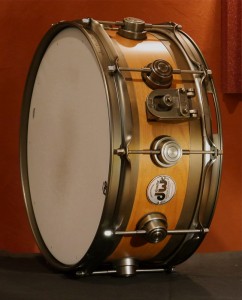 Last not least, I would like to mention a very special snare, that I was able to get hands on: the DW Vault Edge Snare, that was done in cooperation with Sabian – there are only 50 of them made worldwide! It´ s an unbelievable instrument with a build in history: besides of the beautiful vintage look, the material being used is extraordinary: it´s a 14″x 6 11-ply Snare with used Sabian cymbals that had been melted in a special procedure. For the center, they used 700 year old birch that has been laying on the ground of Moosehead Lake in Maine for around 200 years! The sound that has been created through this combination, is very focused, crisp, very defined, extremely sensible – yet quite warm. I haven´t heard this kind of sound before! The snare is nearly playing itself and it´s highly inspirational!
Last not least, I would like to mention a very special snare, that I was able to get hands on: the DW Vault Edge Snare, that was done in cooperation with Sabian – there are only 50 of them made worldwide! It´ s an unbelievable instrument with a build in history: besides of the beautiful vintage look, the material being used is extraordinary: it´s a 14″x 6 11-ply Snare with used Sabian cymbals that had been melted in a special procedure. For the center, they used 700 year old birch that has been laying on the ground of Moosehead Lake in Maine for around 200 years! The sound that has been created through this combination, is very focused, crisp, very defined, extremely sensible – yet quite warm. I haven´t heard this kind of sound before! The snare is nearly playing itself and it´s highly inspirational!
Regarding snare heads, I am pretty much focused on the Remo coated ambassador one ply heads with or without reinforcement such as the coated black dot. The black dot, I am only using for the edge snare and the vintage heads are very nice for a jazz flavor.
DW-Jazz Series
The drum set – being originally a trap set (=collection of things), nowadays obviously has to be understood as a unison. This means that the bass drum, the toms and the snare (not talking about cymbals) has to function in harmony to each other. With no dought, John Good took another step into that direction by developing the jazz series drum set.
I was very excited about the use of a new combination of wood: maple and gum (yes it´s a gum tree!) and I am finding out, that these drums have a totaly new charakter that I wasn´t used to by playing maple or birch. The drums have a lot of tone, sounds full and balanced and has just the right portion of warmth and attack – if you like: overtone. It gets the good old Gretsch sound that I was looking for – but in high quality production!
Of course, you can use these drums for Rock ´n Roll, Funk, Soul, Pop or whatever. Even though I would than rather go for a 22“ bass drum. The idea behind this combination of wood is to be able to tune it very high (such as Peter Erskine) without loosing the warm sound but also to tune it very low (such as Billy Ward) without getting too loose.
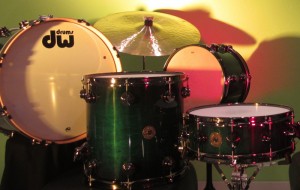 I am using a 18×16“ Bass Drum with a close front head, a little felt damping from inside and I am recommending to use a bass drum riser to get the sweet spot for the beater of the pedal.
I am using a 18×16“ Bass Drum with a close front head, a little felt damping from inside and I am recommending to use a bass drum riser to get the sweet spot for the beater of the pedal.
Or course, the first choise for drum heads are – again – Remo coated ambassador as batter and resonant head. Quiet nice are also the slightly lower Vintage heads or thinner Renaissance heads that have a higher sound.
Last not least, I would like to mention the 6000 hardware which is great to carry around and the vintage tom and ride cymbal mount on the bass drum! It´so much fun!
Closing
Music is as individual as each musician. To find your own sound, it is necessary to get an idea of your sound and visualize what you want to contribute to the music and what the music needs. This is based on your own individual history and influenced by your musical heroes.
If I am looking form my drumsound, I have to listen inside of me and spent a lot of time with the instrument and its potential variations.
Even though to produce a first class drum set, has a certain value, there are many very decent products on the market for a reasonable price. So it is not only a question of money but also a question of imagination an phantasy.

